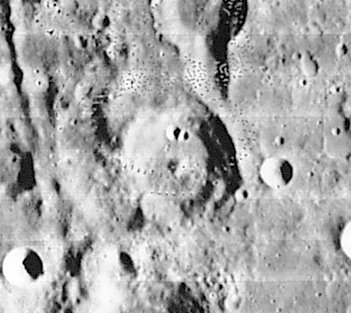Argelander
Contents
Argelander
|
Lat: 16.5°S, Long: 5.8°E, Diam: 34 km, Depth: 2.98 km, Rükl: 56, |
||
Images
LPOD Photo Gallery Lunar Orbiter Images Apollo Images
- Argelander and Vogel (the curious system of craters immediately north of Argelander) were also captured on several frames made by Apollo 16's south-looking mapping/metric Fairchild camera, such as frame AS16-M-0707, in which the curious system of craters (called Vogel) and nearby Argelander are noticeable a little bit below and to the left of the frame's centre.
- Research: Danny Caes.
Maps
(LAC zone 95B2) LAC map Geologic map
Description
Description: Elger
(IAU Directions) ARGELANDER.--This conspicuous ring-plain, about 20 miles in diameter, is, if we except two smaller inosculating rings on the S.E. flank of Albategnius, the most northerly of a remarkable serpentine chain of seven moderately-sized formations, extending for nearly 180 miles from the S.E. of Parrot to the N. side of Blanchinus. Its border is lofty, slightly terraced within, and includes a central peak.
Description: Wikipedia
Additional Information
- Depth data from Kurt Fisher database
- Westfall, 2000: 2.98 km
- Viscardy, 1985: 2.98 km
- Cherrington, 1969: 2.56 km
- Argelander and its satellite crater A are on the ALPO list of banded craters
- Central peak is 0.8 km tall Sekiguchi, 1972. - fatastronomer
- As noted in Named Lunar Formations, Saunder used the central peak of Argelander as a control point (his #1673).
- The system of two connected bowl-shaped craters north of Argelander's central peak, of which one of those two seems to be known as Argelander C, look almost the same as the system of connected craters southeast of Plato, of which one is called Plato J.- DannyCaes Jul 11, 2012
Nomenclature
- Named for Friedrich Wilhelm August Argelander (March 22, 1799 – February 17, 1875), a German astronomer. Argelander was the first astronomer to begin careful study of variable stars. Only a handful were known when he began, and he was responsible for introducing the modern system of identifying them. Together with Adalbert Krüger and Eduard Schönfeld, he was responsible for the star catalogue known as the Bonner Durchmusterung, published between 1852 and 1859, which gave the positions and brightness of more than 324,000 stars. This was the last star map to be published without the use of photography.
- This feature was Catalog number 3559 in Mary Blagg's Collated List. The name appears in Neison, 1876, where it is attributed to Birt. However Julius Schmidt called this feature Airy C, a designation introduced by Beer and Mädler, and used Argelander as the name for the formation now known as Janssen, a designation he says he had used since 1854, including on Lohrmann's charts.
- Neison's use of the name Argelander for the present feature was adopted by the IAU in Named Lunar Formations.
LPOD Articles
Bibliography
F. W. A. Argelander in the Sourcebook Project (William R. Corliss)
- In Mysterious Universe, a handbook of astronomical anomalies (1979) :
- Page 58: Stellar Objects seen during the Eclipse of 1869 (J.R.Hind, Nature, 1878).
- Page 239: Lunar Luminescence (E.J.Flamm, Nature, 1965). Note: from this article we learn the fact of Argelander's observations of the moon, because his name is mentioned in the list of observations of possible luminescence in the vicinity of crater Aristarchus. According to this list, Argelander observed this phenomenon on April 22, 1825.
